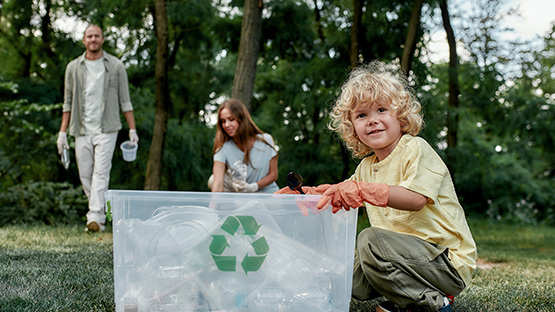Tyre recycling - what do you need to know?
Ekologia

31 January 2023
Recycling car tyres is a process that helps to reduce the amount of waste produced each year. This activity can be carried out by breaking down the tyres into individual parts and shredding them into small pieces. Once the rubber is recycled, it can be used to create new products. Find out what tyre recycling is and why it is important.
Tyre recycling - how does it happen?
The tyre recycling process can be considered in two ways. From the service side and the product side. Both are important and lead to a beneficial effect whereby the tyres can be reused. What is the reason for this division and what does it consist of?
Service recycling is an activity that is carried out by individuals. It is the first step and enables further product recycling. It is the anthropogenic element, which can be divided into:
- collection;
- recovery;
- recycling.
Product recycling is the process proper, i.e. the recovery of components, among other things:
- granulatu;
- energy in the form of fuel;
- wire.
Tyre recycling - methods
Tyres are one of the most difficult materials to recycle due to their composition and size. However, there are several methods that can be used to recycle them. One of these is pyrolysis, which involves heating tyres in an oxygen-free environment. This process breaks down the product into its component parts, which can then be reused.
Another method is gasification, which uses high temperatures and pressure to convert the tyre into gas. This can later be used as a fuel.
Tyres can also be recycled into new tyres through a process called devulcanisation. This process involves removing the vulcanised rubber, which can then be reused to make new tyres.
You can use different types of tyres yourself, for example in the home or garden. What can you make from old tyres? One example is garden flower pots! 
What to do with used tyres?
Used tyres must not be burnt alone. This is very dangerous, both for the burner himself and for everyone in the vicinity where the process takes place. The gases that are produced when decomposing rubber by means of high temperatures are highly poisonous, and inhaling them can result in loss of health or life. Cottage industry incinerators are not equipped to handle this type of treatment and adequately filter the air and the smoke in it.
Used tyres should be taken to a facility that is equipped for this purpose. This ensures that they are incinerated in a controlled and safe manner and allows materials and energy to be recovered. Once the tyres are recycled, they can be used to create new products, such as rubber mulch or playground surfaces.
With used tyres you can go to:
- special containers;
- Selective Waste Collection Point;
- Tyre Disposal Centre;
- the manufacturer of the tyres you own.
What can be done in the case of someone who, for unknown reasons, does not want to decide to recycle their tyres? You can use them in an upcycling process, in other words, give them a new value. In this case, the only limiting factor is your own imagination and creativity. The popular recycled tyre pots are just one example, as they can also be used as, among other things:
- flowerbeds;
- hurdles;
- obstacle courses;
- boxing bags;
- scarecrow;
- sandbox frames;
- wells;
- base for the pond.
Tyre recycling - what does it look like in Poland?
What does tyre recycling look like in Poland? Businesses that manufacture and market tyres are legally obliged to recycle at least 75% (of which 15% must be material recycling) of the product sold. This refers to both new and retreaded units. If a company fails to do so, it is charged a corresponding tax fee. The good news, however, is as follows: the percentage amount of tyres used second-hand exceeds that which is mandated. This means that many companies voluntarily choose to support the environment.
Where can we return used tyres?
How do I start recycling tyres? The most important thing is not to dispose of tyres yourself in landfill sites, whether traditional or wild. This is a legally prohibited and punishable activity in Poland. Those who do not comply with this regulation can expect a fine of PLN 500-5000 (in case the case goes to court).
Used tyres need to be taken to a location that is designed for this. What is the price of tyre recycling? If you go to a tyre workshop, you will usually have to reckon with a cost of around £5 per tyre for cars and £20 per tyre for lorries. However, this is not the rule. Some companies undertake this task free of charge.
Another way, which does not require payment, is to go to a PSZOK or CUO. The downside of this solution is that the first place often has low annual limits (e.g. four) and the second requires tyres to be donated in bulk. The best way is to get rid of rubber waste at local collections. These are free and usually take place where you live.
What does rubber waste disposal look like in practice? It is quick and hassle-free. Most vulcanisation shops are equipped with a tyre recycling machine. Therefore, when you return them, you don't have to wait for anything. Just leave the tyres, pay (if the company offers this service for a fee) and leave. 
Tyre recycling - what is produced and what is made from tyres?
Every year, millions of tyres are illegally dumped, taking up valuable space in forests. Such dumping can be a source of pollution, releasing harmful chemicals into the environment. Fortunately, there are ways to recycle used tyres.
One method of treating used tyres is the so-called Tyre Derived Fuel (TDF). TDF involves shredding tyres and using them as fuel in cement kilns, paper mills or power plants. This process can reduce greenhouse gas emissions and save energy.
What else is made from recycled tyres? Another option is to use their shavings as an alternative to gravel in construction projects. Tyre chips can also be used as landscaping material or in playgrounds. Finally, rubber from used tyres can be recycled into new tyres, flooring, mats, shoe soles, doormats and other products. Recycling rubber helps to reduce pollution and conserve natural resources.
Tyre recycling by its definition also includes retreading, which is the process of adding new tread to used tyres. This can significantly extend their life and is a cheaper option than buying new. Retreading is a process that must be carried out by a trained professional. Although it is easy to find amateur videos of home-made methods of performing the process on the internet, nothing should be repeated. Poorly performed retreading can cause the tyres to lose their grip when driving and cause a dangerous accident.
Can any type of tyre be retreaded?
The most important element of a car tyre is the tread. It prolongs the tyre's life, ensures the vehicle's grip in various road conditions and makes it quieter on flat surfaces. It is the tread that is damaged first as a result of constant friction against the running surface. If it has worn out, does this mean that the user is condemned to recycle used car tyres? There is one more step that can be taken before the tyre is sent for destruction, and that is to retread it. In this way, even more material can be recovered and the tyre becomes useful again.
Such a process involves
- removal of old tread;
- verifying the technical condition of the tyre body;
- retreading (hot or cold).
Cold retreading is a cheaper option, which is quicker to perform but does not guarantee the same level of safety (it can peel off). In addition, it is not as environmentally friendly as hot retreading - which in turn is more expensive, requires longer lead times and can only be carried out by the tyre manufacturer. The advantage of this solution is that the resulting product is like new.
Can any type of tyre be retreaded? Yes, any type. But on certain conditions, namely that the tyre casing must not be damaged. The tyre should not have any cracks, deformations or other signs suggesting any danger in its future use.
However, retreaded tyres have considerable disadvantages. The most important of the problems is the inability to check the condition of the casing and seal. For this reason, such tyres are often used for reconstruction and can be a source of great risk when driving. In addition, retreaded tyres are inferior in terms of performance, safety and durability to new tyres.
Tyre recycling - what materials in a tyre can be recycled?
What does material recycling of tyres look like? In this case, the raw materials that can be processed in preparation for secondary use are:
- steel (wires);
- textiles;
- rubber.
These semi-finished products can be reused in construction, transport and even in the energy, heavy and manufacturing industries. As you can see, nothing goes to waste.
Tyre recycling and disposal are environmentally important topics. The growth of motorisation means an increased demand for natural resources, which in turn contributes to accelerated environmental damage. Most of this is avoidable. This is why electric vehicles have recently become increasingly popular. By deciding to actively participate in the car tyre conversion process and, for example, purchasing a zero-emission car, you are making a significant contribution to limiting progressive climate change.
Czytaj również

Where to donate your clothes? Give them a second life together with InPost!
Where to donate clothes you no longer wear? Instead of throwing away good clothes, it is worth donating them to others for further use. Do...

Where to give away unwanted electronic equipment? Small items can still be useful
Electronic equipment is one of the most frequently replaced items in the home. New ones are not always bought when the old ones are no lon...

Where to donate toys you no longer need? We have a good way to do it!
Quite a few children have rooms full of toys. They receive more gadgets from grandparents, parents or aunts and uncles. Sometimes the obje...



